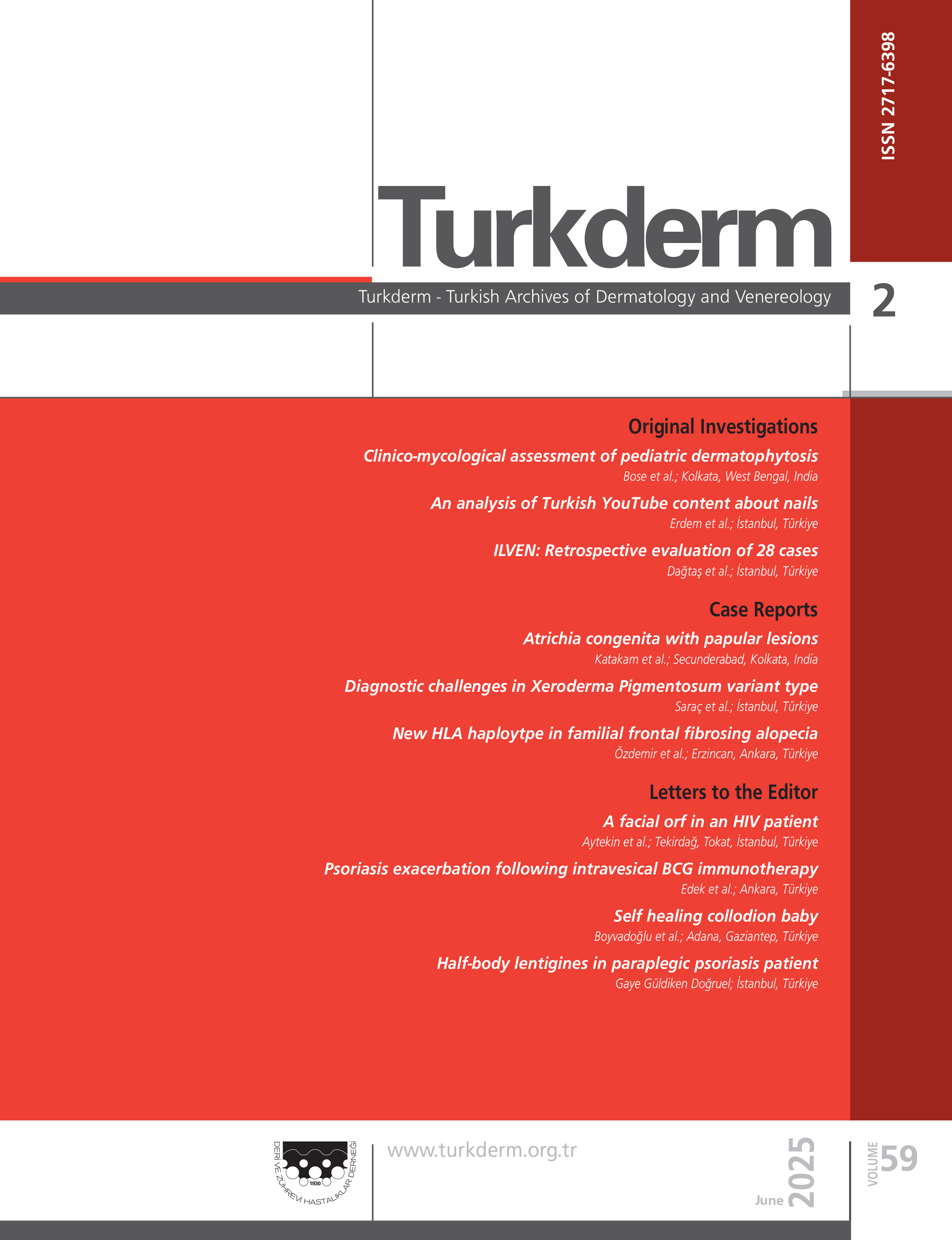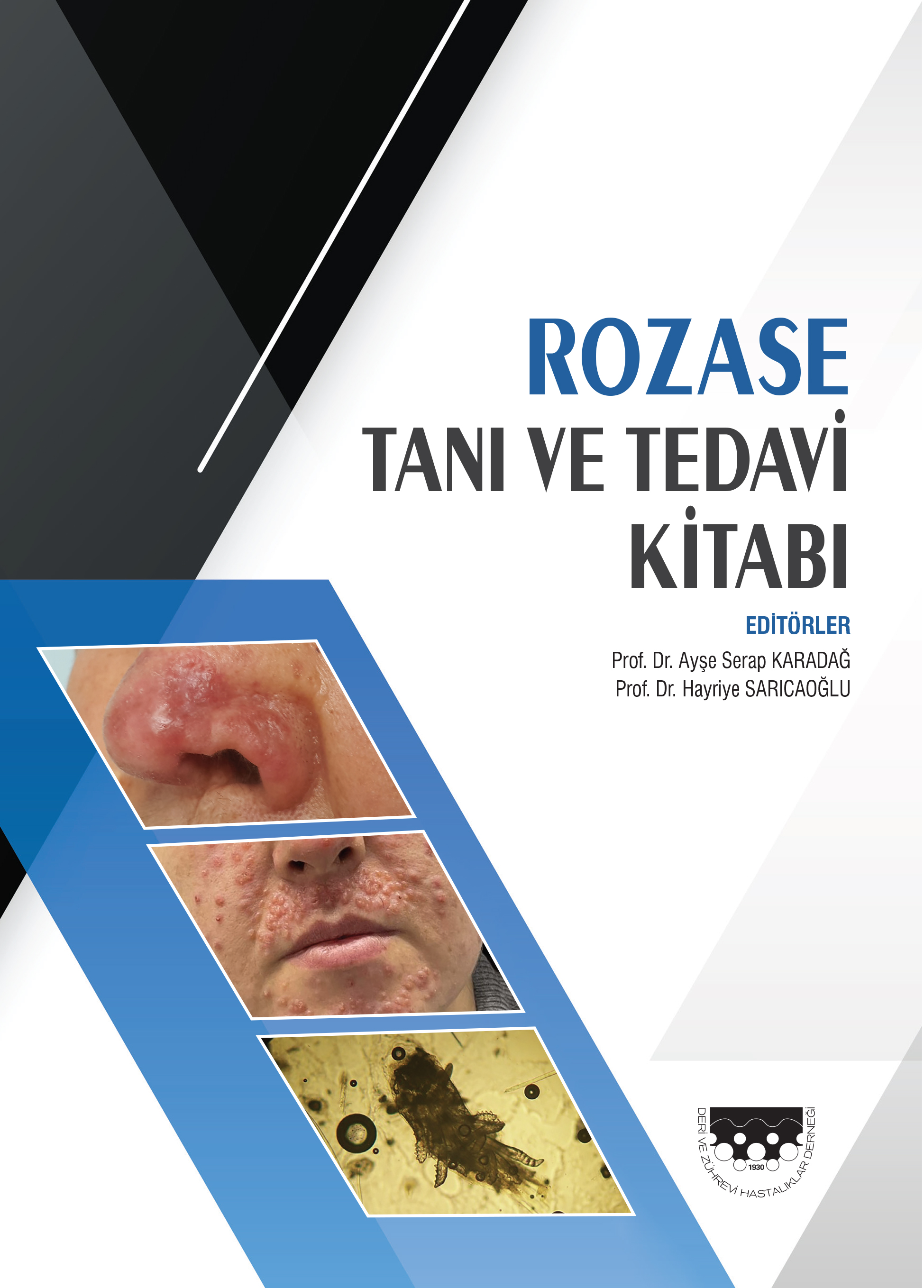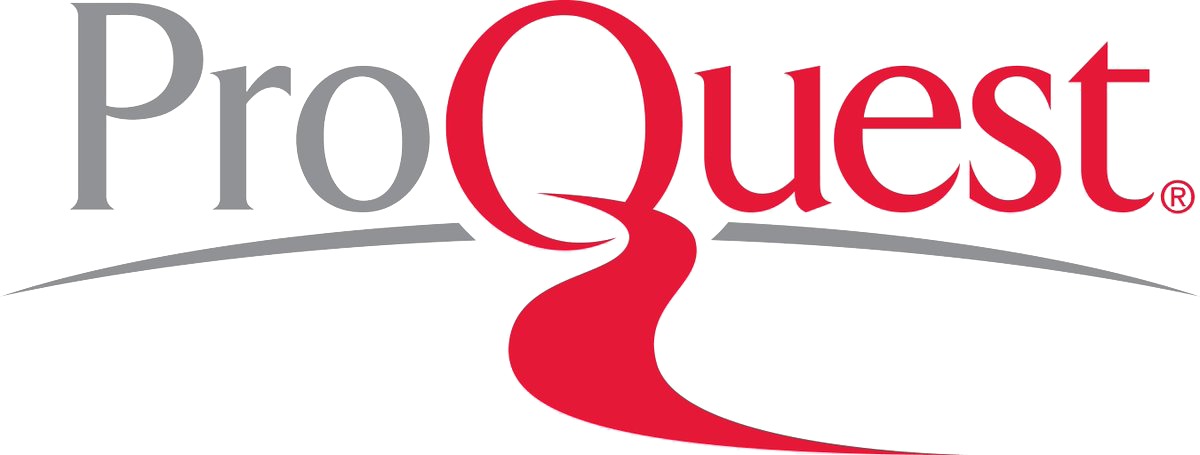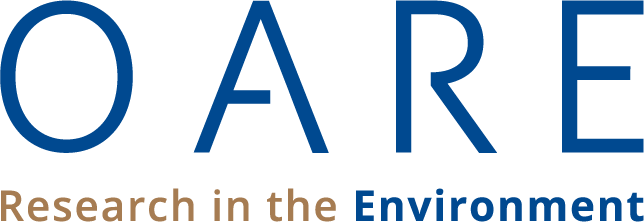Volume: 41 Issue: 1 - 2007
| BAŞ YAZI | |
| 1. | Our Associations Ertuğrul H. Aydemir Pages 1 - 2 Abstract | |
| DERLEME | |
| 2. | The Use of Ultrasonography in Dermatology İjlal Erturan, Mehmet Yıldırım Pages 3 - 6 The term ultrasound refers to sound waves of a frequency that is above the human hearing range. Ultrasonography has an established diagnostic role in many fields of medicine. Ultrasound imaging, while initially developed to visualize internal organs, is now being applied to image the skin. Skin imaging began with determination of skin thickness in 1979. Recently ultrasound have been used to image cutaneous neoplasms and skin diseases. The main advantages of this method of imaging include its non-invasiveness, safety, high patient tolerability and relatively low cost. |
| ORJİNAL ARAŞTIRMA | |
| 3. | Patch Testing: Is pre patch testing series consisting of less allergens more practical? Fatma Elif Demirgüneş, Sibel Ersoy Evans, Gonca Boztepe, Nilgün Atakan Pages 7 - 10 Background and Design: The aims of this study were to evaluate the patch test results and demographic characteristics of patients who underwent patch testing with European standard series (ESS) and to verify if the patch test panel can be narrowed or not. MATERIALS-METHODS: Data of 74 patients who had a patch test with ESS were evaluated retrospectively. Of those, 58 had contact dermatitis, 3 had atopic dermatitis, and 13 had other diagnoses. Patch test results were analyzed with student's t test and Pearson correlation test. RESULTS: The median age of the 74 patients in the study group (F = 51, M = 23) was 29 years (range: 5 to 76 years). Positive allergic reactions were observed to a minimum of 1 and a maximum of 4 chemicals in a total of 35 (48.6%) patients after 72 hours. The 6 most common allergens that caused positive reactions were nickel (n = 18), cobalt chloride (n = 9), balsam of Peru (n = 6), fragrance mix (n = 6), neomycin sulphate (n = 5), and potassium dichromate (n = 4). Of the 35 patients with positive patch test results in 30 (%85.7) of the patients the reactions were against these most common 6 agents. There were no positive reactions to 10 of 25 chemicals in ESS. Concurrent positive results were noted with 2 chemicals in 8 patients (22.8%), 3 chemicals in 6 patients (9.4%), and 4 chemicals in one patient (2.8%). CONCLUSION: The results of patch tests should be evaluated regularly in order to update the patch test components. We recommend a test series consisting of the 6 most common allergens in order to decrease both the costs associated with the test and contact sensitization, which may be the most serious side effect of patch testing. |
| 4. | Effect of Caffeic Acid Phenethyl Ester on Plasma Lipid Peroxidation, Antioxidant Status and Nitric Oxide Levels in Incisional Wound Model Gamze Serarslan, Muhammed Enes Altuğ, Tünay Kontaş Pages 11 - 14 Background and Design: Wound healing is a complex pathophysiologic process involving interplay of several cellular and biochemical processes. Several natural products have been shown to accelerate the healing process in studies. In this study we aimed to determine the efficacy of caffeic acid phenethyl ester (CAPE), which is an extract of honeybee propolis on wound healing in rats. MATERIALS-METHODS: Fourty male Wistar albino rats were divided into two groups as treatment (n=20) and control (n=20) group. A linear full thickness incision was performed on the back of each rat and sutured. After incision, during the study period CAPE was administered to the treatment group and saline was administered to the control group every day. Bloods of 5 animals from each group were collected on the experiment days of 1st, 3rd, 7th and 14th for biochemical analysis. RESULTS: A significant increase in glutathione and nitric oxide levels and a significant decrease in malondialdehyde levels and superoxide dismutase activities in CAPE group were detected when compared to the control group. CONCLUSION: In the study it determined that CAPE showed an antioxidant effect on wound healing and suppressed lipid peroxidation. In conclusion, because of these properties, CAPE may be useful in wound healing. |
| 5. | Does cytomegalovirus have a role in the etiology of mycosis fungoides? Ayse Gül Erdoğan, Deniz Balaban, Aynur Karaoğlu, Neslihan Dolar, Meral Mutlu, Kadriye Yaşar Pages 15 - 18 Background and Design: It is controversial whether cytomegalovirus (CMV), an immunostimulator agent, plays a role in the etiopathogenesis of mycosis fungoides (MF). To investigate a possible linkage between CMV and MF, we designed a prospective clinical study. MATERIAL-METHOD: Patients with biopsy proven MF (n=29) and age/sex matched healthy control subjects (n=29) were included in the study. Sera of both groups were quantitatively investigated with micro-ELISA for the presence of anti- CMV immunoglobuline-G (IgG). RESULTS: All patients with MF had abnormally elevated levels of anti-CMV IgG in their sera, whereas 25 (86%) patients in control group showed higher levels of anti- CMV IgG than normal (p>0.05). The antibody levels measured in patients and healthy control subjects were 4.6 ± 1.2 ISR (range 2.6-6.6 ISR) and 4.1 ± 1.7 ISR (range 0.9-6.5 ISR), respectively (p>0.05). CONCLUSION: Levels of anti-CMV IgG in Turkish patients with MF are not significantly different than the levels of healthy control subjects. |
| 6. | Screening of antibiotic resistant Propionibacterium acnes from acne vulgaris patients: Data from Pamukkale University. Çağrı Ergin, Şeniz Ergin, İlknur Kaleli, Mustafa Şengül, Berna Ş.Erdoğan Pages 19 - 21 Background and Design: Antibiotic resistant Propionibacterium acnes is the main etiologic factor for failure of the acne therapy. In this study, the prevalance of antibiotic resistant P.acnes was investigated in our region. MATERIAL-METHOD: One hundred ninty-two acne vulgaris patients admitted to dermatology clinic were included in the study. Demographic and clinical data were recorded. Anaerobic culture was used for the samples collected by detergent scrub technique. Agar dilution technique was chosen for strains' antimicrobial susceptibilities. RESULTS: Propionibacterium acnes was isolated from 117 (60.9%) of 192 acne vulgaris patients. Antibiotic resistance of P.acnes was found in 10 (8.54%) strain. Erythromycin (9 strain), clindamycin (7 strain) and tetracycline (1 strain) resistance was found as 7.7%, 6.0% and 0.9%, respectively. Doxycyline resistance was not found. CONCLUSION: The prevalance of antibiotic resistant P.acnes is low and therapeutic failure is not expected due to resistant strains. Resistance rates of P.acnes may be detect via community surveillance programmes. |
| OLGU SUNUMU | |
| 7. | Cutaneous metastasis of pleural malignant mesothelioma Mustafa Özdemir, Munise Gümüşel, Hatice Toy Pages 22 - 24 Pleural malignant mesothelioma is a rare tumor. Metastasis of malignant mesothelioma is through both local invasion and hematogenous routes and occurs at various stages of the disease. In this article, we present a case with cutaneous metastasis of plural malignant mesothelioma, which is rarely seen and review the literature on skin metastasis of malignant mesothelioma. |
| 8. | Paraneoplastic pemphigus in a patient with B cell non-hodgkin lymphoma Kurtuluş Didem Yazganoğlu, Sevil Bavbek, Nesimi Büyükbabani, Can Baykal Pages 25 - 27 Paraneoplastic pemphigus (PNP) is a rare type of pemphigus which is seen in association with lymphoproliferative diseases, most commonly with non-Hodgkin's lymphoma and several other malignities. The disease presents with severe mucosal involvement, polymorphous skin eruption and respiratory problems. It has its own histopathologic features and immunfluorescence findings unlike the other types and has a poor prognosis. In this report, we describe a patient who developed PNP in two years after the diagnosis of B cell non-Hodgkin lymphoma. |
| 9. | A Case of Kindler Syndrome Mukaddes Kavala, Sibel Südoğan, Burçe Can, Özlem Albayrak Pages 28 - 30 Kindler syndrome is a rare, autosomal recessive disorder that combines clinical features of hereditary epidermolysis bullosa and poikiloderma congenitale. It is characterized by acral blistering and photosensitivity early in life, followed by progressive poikiloderma and cutaneous atrophy. Kindler syndrome is caused by mutations in skin protein, named kindlin-1, which plays a role in cell-matrix adhesion. Here we report a 27-year-old man presented with acral blistering, contracture of the fingers, generalized cutaneous atrophy, periodontitis and difficulty in swallowing. None of the other members of the family are affected. |
| YENİ YAYINLAR | |
| 10. | New Books Page 31 Abstract | |
| HABERLER | |
| 11. | Society News Page 32 Abstract | |
| KONGRE TAKVİMİ | |
| 12. | Kongre takvimi Page 33 Abstract | |
| SİMPOZYUM | |
| 13. | Dermatoloji 2007 Bahar Simpozyumu programı Page 34 Abstract | |























